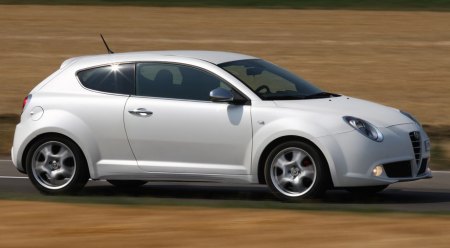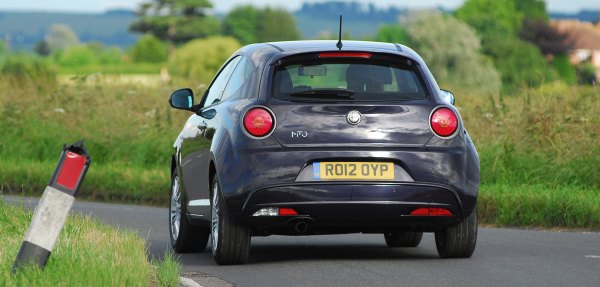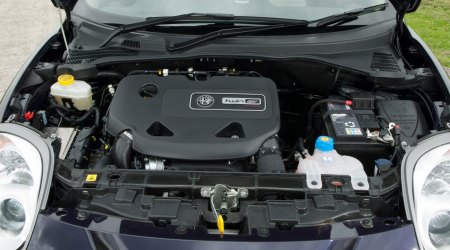|
|
Alfa Romeo MiTo
|
 |
|
|
Debut: 2008
Maker: Alfa Romeo
Predecessor:
no
|
|
|
|
| Published
on 29
Jun
2008 |
All rights reserved.
|
|
|
Alfa's first supermini targets at Mini
|
After
Brera, this is another Alfa Romeo named after a place - well, two
places actually - Milan (where the car is designed) and Torino (or
Turin, where it is produced). MiTo is Alfa Romeo's first entry into the
B-segment, a class including its target rival Mini and its platform
donor Fiat Grande Punto, among others. This is a big market segment
that Alfa Romeo used to omit. Expanding to this segment will get at
least 70,000 additional orders a year and help Alfa meeting its sales
target of 300,000 units by 2010, provided it won't steal sales from the
aging 147.
Although Fiat Grande Punto provides a solid basis for MiTo, Alfa still
needed to differentiate itself from the bread-and-butter Fiat. A great
design certainly helps. Alfa Romeo design center did a great job to
style the MiTo like a supermini version of its 8C Competizione
supercar. Look at those flowing surfaces and the dramatic front end
design elements (which apparently link to the classic Giulietta Sprint
and Zagato), or the jewel effect headlamps and taillights, who can
resist its temptation ? Especially in red, the MiTo delivers greater
visual impact than any other cars in the supermini segment.
A supermini version of 8C Competizione
?
|
Inside,
the
cabin
design is less special, although material quality, fit and finish seems
a good match to Mini. You can opt for a carbon-fiber-like dash trimming
and great-looking leather seats. As expected, the rear seat is a little
cramped by class standard and the boot is small.
The baby Alfa shares many underpinnings and identical wheelbase with
Grande Punto, but there are also a lot of enhancement. Its smooth
bodyshell returns a lower drag coefficient (0.29 vs 0.31). It has 10 mm
wider tracks and a lower roof to enhance maneuverability. Its
suspensions employ stiffer springs and new dampers incorporating
rebound springs for better control. Its steering has faster ratio. Its
brakes are uprated.
Material quality, fit and finish seems
a good match to Mini...
|
Then there are countless of electronic driving aids: VDC stability
control, ASR traction control, Q2 electronic brake differential (which
applies braking on individual front wheels to simulate the effect of
LSD), DST dynamic steering torque (which applies assisting torque to
the steering wheel to help correcting under/oversteer)... Above them is
an integrated control system interestingly called "DNA", which offers 3
driving modes (Dynamic, Normal and All-weather) for the driver to
select. Each mode alters the setting of the aforementioned electronic
driving aids as well as throttle response, steering assistance and
overboost function to the turbocharged engine. It sounds very upmarket.
Remarkable dynamics except the
steering...
|
As in
other
Fiat
models, MiTo offers a wide range of competitive engines - 78hp 1.4 8V,
95hp 1.4 16V, 120hp 1.4 turbo and 155hp 1.4 turbo petrol, 90hp 1.3JTDM
and 120hp 1.6JTDM diesel. Our pick of the range is certainly the 155hp
1.4-liter turbo. It is the same as the one employed by Grande Punto
Abarth. Maximum torque of 152 lb-ft is reached at only 2000 rpm,
boosting real-world performance as well as fuel economy. Should you
need more, switch the DNA control to Dynamic mode and you will have an
overboost to 170 lb-ft some 1000 rpm later. It takes only 7.6 seconds
to go from 0-60 mph. (If that is still not enough, then you will have
to wait for the GTA version, whose 1.8-liter turbo engine employs an
innovative continuous variable valve lift to achieve a fearsome 230
horsepower)
1.4-liter turbo comes from FIAT Grande
Punto Abarth
|
On the
road,
the 1.4
turbocharged engine is excellent, being punchy from the mid-range and
willing at the top end. The MiTo feels quick and lively. Its handling
is also competent - grippy, little body roll, resistant to understeer
and good brakes. Ride quality and refinement is good except over big
bumps. Everything meets our expectation for a modern sporty premium
hatchback... except the steering, which is a big let down. Fiat group's
electrical power steering has never been famous for communication. Now
further complicated by the DST - like BMW's notorious Active Steer -
and DNA, the steering gets even more wooden. There is virtually no feel
in straight ahead position, and barely the slightest feel at lock.
Sadly, the baby Alfa could have shot to the top spot of our supermini
chart, but this poor steering setup ruined the chance.
|
Verdict:     |
| Published
on 30
Oct
2009 |
All rights reserved.
|
|
MiTo Cloverleaf and Multiair engines
|
From twin-cam to
twin-spark, then JTS (direct-injection) and finally Multiair, Alfa
Romeo's engine technology has moved increasingly from performance to
environment-oriented. For sure, Multiair variable
valve timing and lift
is a revolutionary technology. Everybody wants to have higher degree of
control
on valve operation than today's VVT / VVL systems. However, no one else
has thought of using a hydraulic linkage and a solenoid valve to
realize that. It is simple, space-saving and cost effective.
It is easily compatible with existing engines. Best of all, it improves
horsepower, low-down torque and fuel economy by 10%, 15% and 10%
respectively.
In this way, Alfa Romeo produced a trio of 1.4-liter
Multiair engines for Mito – 105hp without turbo, 135hp with light turbo
and 170hp with large turbo. The latter achieves a spectacular 124
horsepower per liter yet 46 mpg European combined consumption – partly
thanks to the new automatic start-stop function. Even with that high
specific output, the Multiair engine displays virtually no turbo lag,
thanks to the strong low-end response of the Multiair technology. FIAT
achieves what Volkswagen's 1.4 twin-charger engine did without its
additional cost.
Multiair delivers strong output
and low consumption, but an important quality is missing...
|
 |
However, there is an important quality missing from the Multiair engine
– the thrilling character of traditional Alfa Romeo engines. Because
Multiair has a single camshaft instead of two, in addition to the extra
friction and inertia in the electrohydraulic linkage, it can never rev
to 7000 rpm like the great Alfa twin-cam / twin-spark of the old. In
fact, the Multiair engine gives little reward after 5000 rpm, so you
are no longer tempted to stretch its rev. Aurally, it is no match with
the old twin-cam / twin-spark too. No matter you like or not, the call
for low-carbon economy is going to change the motoring world forever,
sadly.
The Mito equipped with the 170hp Multiair engine is called
"Quadrifoglio verde" (translate to "green cloverleaf" according to
Google). In English-speaking countries, it is simply called Mito
Cloverleaf. Apart from the hotter engine, this car also gets a
brand-new 6-speed manual gearbox, an electronic adaptive damping
(linked to the DNA control system which provides four driving modes),
retuned suspension and steering, and a set of nice looking 17-inch
alloy wheels wrapped with 215/45 tires.
On the road, you will find the new gearbox slick and sweet. The
steering weighs more consistently than before, if still short of real
communication. Adaptive damping smoothens its ride on broken surfaces
while tightens body movement in corners, so its combination of handling
and ride is considerably better than other Mitos. As before, there is
plenty of grip from the front wheels, and the Q2 electronic (pseudo)
differential works well to prevent wheelspin in tight corners. The Mito
is fool-proof to drive on whatever roads. On the downside, its chassis
lacks interaction with the driver, so it fails to entertain keen
drivers like Renault Sport Clio Cup. Neither does it offer the raw
excitement of the hardcore Abarth Punto SS.
At the mean time, Cloverleaf replaces the outgoing 1.4TB as the hottest
Mito. Alfa Romeo originally planned to introduce a 230hp GTA as range
topper. Unfortunately, that plan has been postponed due to
economic recession. Facing strong rivals like Clio RS, Punto Abarth
and Mini Cooper S, Mito Cloverleaf won't find its life easy, despite of
that brilliant engine. |
Verdict:    |
| Published
on 22
Jul
2012 |
All rights reserved.
|
|
MiTo TwinAir
|
|

|
Instead of a mid-life
facelift, Alfa Romeo celebrates the 4th birthday of MiTo with a new
engine: TwinAir. The 875 cc twin-cylinder Multiair-valve-controlled
turbocharged engine has been introduced to Fiat 500, 500L, Punto and
Lancia Ypsilon already. However, the installation to Alfa MiTo is the
best yet. Why? Firstly, this latest version is improved with dual-mass
flywheel (like the recent Punto TwinAir) to reduce a large part of its
inherent vibration, so it feels refined enough for most of the time.
Secondly, the characterful twin-cylinder thrum is a perfect match to
the fun character of Alfa Romeo, just like how the old boxer engines
enhanced the appeal of Alfasud. It complements the lack of aural appeal
on the four-cylinder Multiair engines. Lastly, the TwinAir brings
class-leading green figures of 67.3 mpg and 98 g/km of CO2.
Even though it is impossible to replicate the figures in real world,
they warrant low tax rate and pollution charges in most European
countries.
The 85-horsepower motor offers limited performance – 108 mph top speed
and nearly 12 seconds to go from 0-60 mph – but in regular driving
conditions it feels quite brisk, thanks to a maximum torque of 107
pound-foot. For overtaking, it is vital to keep the engine revving at
its strongest power band of 2000-3500 rpm. You will also need to switch
the DNA control to Dynamic mode, which releases the full power and a
sportier exhaust note by the way. In less demanding conditions, Normal
mode's 78 hp and 81 lbft output is more than sufficient to maintain
progress. It smoothens the power delivery and helps cutting fuel
consumption. Aside from some noticeable vibration observed in idle and
near 5000 rpm redline, the TwinAir motor is pretty smooth. Only the
off-beat exhaust note reminds you a twin-cylinder engine is hanging at
the nose. Highway cruising is refined, too, as the engine registers
only 3000 rpm at 70 mph.

|
The TwinAir engine is a few dozen kilograms lighter than its four-pot
equivalent. This reflects in the car's keener turn-in. Otherwise, it
drives with the same manner of other MiTos. The electric power steering
is very quick but devoid of feel. Good grip and body control are
accompanied with a hard ride and excessive noise. It is not as polished
as an Audi A1 or Citroen DS3, but if all you ask is raw fun, the Alfa
has plenty to satisfy you, especially now accompanied with a
characterful exhaust note.
|
Verdict:     |
|
|
|
|
|
|
|
|
|
|
MiTo 1.6JTDM
|
2008
|
| Front-engined,
FWD |
| Steel monocoque |
| Mainly steel |
| 4063 / 1721 / 1446 mm |
| 2511 mm |
Inline-4, diesel
|
| 1598 cc |
DOHC 16 valves
|
VTG turbo
|
| CDI |
| 120 hp |
| 236 lbft |
| 6-speed manual |
F: strut
R: torsion-beam
|
| - |
| 195/55R16 |
1205 kg
|
| 123 mph (c) |
9.3 (c)
|
| - |
|
MiTo
1.4 Turbo
|
2008
|
| Front-engined,
FWD |
| Steel monocoque |
| Mainly steel |
| 4063 / 1721 / 1446 mm |
| 2511 mm |
| Inline-4 |
| 1368 cc |
DOHC 16 valves
|
Turbo
|
| - |
| 155 hp |
152 lbft (overboost 170 lbft)
|
| 6-speed manual |
F: strut
R: torsion-beam
|
| - |
| 195/55R16 |
1145 kg
|
| 134 mph (c) |
7.7*
|
| 23.3* |
|
MiTo 1.4 Multiair
|
2009
|
| Front-engined,
FWD |
| Steel monocoque |
| Mainly steel |
| 4063 / 1721 / 1446 mm |
| 2511 mm |
| Inline-4 |
| 1368 cc |
SOHC 16 valves, VVT+VVL
|
-
|
| - |
| 105 hp |
96 lbft
|
| 6-speed manual |
F: strut
R: torsion-beam
|
| - |
| 195/55R16 |
1090 kg
|
| 116 mph (c) |
10.1 (c)
|
| - |
|
|
|
|
|
Performance
tested by: *Autocar
|
|
|
|
|
|
|
MiTo 1.4 Multiair Turbo
|
2009
|
| Front-engined,
FWD |
| Steel monocoque |
| Mainly steel |
| 4063 / 1721 / 1446 mm |
| 2511 mm |
| Inline-4 |
| 1368 cc |
SOHC 16 valves, VVT+VVL
|
Turbo
|
| - |
| 135 hp |
152 lbft
|
| 5-speed manual |
F: strut
R: torsion-beam
|
| - |
| 195/55R16 |
1135 kg
|
| 129 mph (c) |
7.9 (c)
|
| - |
|
MiTo Cloverleaf
|
2009
|
| Front-engined,
FWD |
| Steel monocoque |
| Mainly steel |
| 4063 / 1721 / 1446 mm |
| 2511 mm |
| Inline-4 |
| 1368 cc |
SOHC 16 valves, VVT+VVL
|
Turbo
|
| - |
170 hp / 5500 rpm
|
184 lbft / 2500 rpm
|
| 6-speed manual |
F: strut
R: torsion-beam
|
Adaptive damping
|
| 215/45R17 |
1145 kg
|
| 135 mph (c) |
7.2 (c)
|
| - |
|
MiTo TwinAir
|
2012
|
| Front-engined,
FWD |
| Steel monocoque |
| Mainly steel |
| 4063 / 1721 / 1446 mm |
| 2511 mm |
| Inline-2 |
| 875 cc |
SOHC 8 valves, VVT+VVL
|
Turbo
|
| - |
85 hp
|
107 lbft
|
| 6-speed manual |
F: strut
R: torsion-beam
|
Adaptive damping
|
| 195/55R16 |
1055 kg
|
| 108 mph (c) |
11.8 (est)
|
| - |
|
|
|
|
|
Performance
tested by: -
|
|
|
|
|
|
|
|
|
Copyright©
1997-2012
by Mark Wan @ AutoZine
|
|